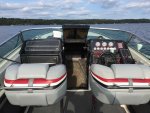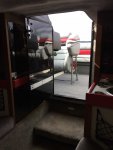FormulaCanada
Cadet
- Joined
- Jan 13, 2016
- Messages
- 18
Hey all...first post here. I'm looking at buying a boat in my area (Georgian Bay area in Canada). I don't know much about the history of the boat so it could very well have come from a salt water life. Maybe maybe not.
Anyway, the out drive looks oddly corroded. Seems like the bottom skeg portion of the outdrive is corroded. Looks to me like the zinc is missing on that outdrive.
I haven't gone to look at the boat, maybe this or next weekend, but the outdrives have me second guessing even going to look.
It's a 1987 Formula 272, Alpha drives, 350 small blocks, pretty decent shape overall. Conversion would make it $10,200USD. Hour meter says 192hrs...seems unbelievable to me...but who knows.
What do you all think? Is this priced fairly?
Seems to be a limit here for the images. Please take a look at my thread over at hull truth (sorry, for the link)...don't have an image editor at work to resize.
http://www.thehulltruth.com/boating-forum/727800-formula-272-outdrive-corrosion.html#b
Rob
Anyway, the out drive looks oddly corroded. Seems like the bottom skeg portion of the outdrive is corroded. Looks to me like the zinc is missing on that outdrive.
I haven't gone to look at the boat, maybe this or next weekend, but the outdrives have me second guessing even going to look.
It's a 1987 Formula 272, Alpha drives, 350 small blocks, pretty decent shape overall. Conversion would make it $10,200USD. Hour meter says 192hrs...seems unbelievable to me...but who knows.
What do you all think? Is this priced fairly?
Seems to be a limit here for the images. Please take a look at my thread over at hull truth (sorry, for the link)...don't have an image editor at work to resize.
http://www.thehulltruth.com/boating-forum/727800-formula-272-outdrive-corrosion.html#b
Rob

























